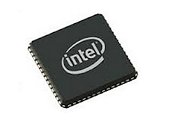- Joined
- Oct 9, 2007
- Messages
- 47,241 (7.55/day)
- Location
- Hyderabad, India
| System Name | RBMK-1000 |
|---|---|
| Processor | AMD Ryzen 7 5700G |
| Motherboard | ASUS ROG Strix B450-E Gaming |
| Cooling | DeepCool Gammax L240 V2 |
| Memory | 2x 8GB G.Skill Sniper X |
| Video Card(s) | Palit GeForce RTX 2080 SUPER GameRock |
| Storage | Western Digital Black NVMe 512GB |
| Display(s) | BenQ 1440p 60 Hz 27-inch |
| Case | Corsair Carbide 100R |
| Audio Device(s) | ASUS SupremeFX S1220A |
| Power Supply | Cooler Master MWE Gold 650W |
| Mouse | ASUS ROG Strix Impact |
| Keyboard | Gamdias Hermes E2 |
| Software | Windows 11 Pro |
Intel is readying the i225-V "Foxville," its new generation of low-cost Ethernet PHY controllers for client-segment motherboards and notebooks. With it, the company will be mainstreaming 2.5 Gbps as the client-segment wired-networking standard, after nearly 15 years of 1 GbE dominance. The i225-V is expected to feature in the upcoming wave of socket LGA2066 motherboards for Intel's "Cascade Lake-X" HEDT processors, followed by the company's 400-series chipset that launches alongside the "Comet Lake-S" MSDT processors. The i225-V isn't the first of its kind, with the likes of Realtek and Broadcom having already launched 2.5 GbE PHYs. The Intel chip, however, is expected to mainstream the standard as it's currently the most popular GbE PHY brand with the success of the i219-V and i218-V.
Much like the i219-V, the i225-V is a low-cost PHY that relies on PCH-based Ethernet MAC and its proprietary PCIe-based bus that runs at half the data-rate of PCIe. This is precisely why the i219-V doesn't feature on AMD motherboards, but rather its pricier sibling, the i211-AT, which comes with an integrated MAC and a standard PCIe interface. Both chips are known to offer identical throughput performance, however, the i211-AT edges ahead with some features such as TCP segmentation, direct cache access, etc. The i219-V sells for as little as $1.5 per chip in high-volume reels to motherboard manufacturers, and the i225-V is expected to be priced roughly similar. In contrast, the i211-AT goes for almost $3.25 a pop. Intel is yet to publish documentation that details software features of the i225-V, but the Linux community is already on the job at developing drivers. 2.5 GbE uses existing Cat5E/Cat6 cabling requirements as 1 GbE, and hence has a better chance at mainstreaming compared to 10 GbE, which has been around for a decade, with little success in the client segment.

View at TechPowerUp Main Site
Much like the i219-V, the i225-V is a low-cost PHY that relies on PCH-based Ethernet MAC and its proprietary PCIe-based bus that runs at half the data-rate of PCIe. This is precisely why the i219-V doesn't feature on AMD motherboards, but rather its pricier sibling, the i211-AT, which comes with an integrated MAC and a standard PCIe interface. Both chips are known to offer identical throughput performance, however, the i211-AT edges ahead with some features such as TCP segmentation, direct cache access, etc. The i219-V sells for as little as $1.5 per chip in high-volume reels to motherboard manufacturers, and the i225-V is expected to be priced roughly similar. In contrast, the i211-AT goes for almost $3.25 a pop. Intel is yet to publish documentation that details software features of the i225-V, but the Linux community is already on the job at developing drivers. 2.5 GbE uses existing Cat5E/Cat6 cabling requirements as 1 GbE, and hence has a better chance at mainstreaming compared to 10 GbE, which has been around for a decade, with little success in the client segment.

View at TechPowerUp Main Site








